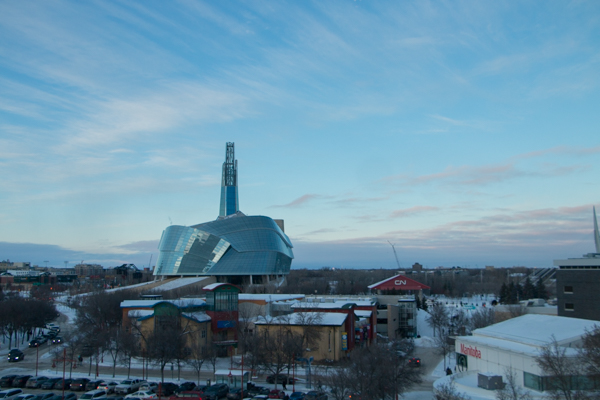The Railside at the Forks development started construction work in August 2021, following the announcement of the project in 2013. The development is planned to include housing, community and business spaces where two parking lots sandwiched between the CN rail line and Israel Asper Way are currently situated. The plots of land are being divided into two communities called Railside North and Railside South.
The reason the project took so long to get going after its announcement was primarily due to financial constraints and bylaws. Finances improved for the Forks’ development after the provincial government opted to renounce $11.9 million worth of property taxes in 2019 to help stimulate the undertaking. Following this decision, in 2020, the City of Winnipeg offered the project $7.9 million in rebate-based subsidies.
After financial support was offered, vice-president of strategic initiatives for the Forks Clare MacKay noted that developers “will be looking at archeology, we’ll be looking at geothermal. Those are the first steps we are taking.”
The Forks hosts one of Manitoba’s largest archeological sites and, following the excavation of the area where the Canadian Museum for Human Rights (CMHR) now sits, archaeologists described it as one of the most important, too. The Forks has been a meeting place for Indigenous people for over 6,000 years and is now a nationally recognized historic and heritage site. As such, between 2008 and 2012, the developers of the CMHR were required to excavate the area in conjunction with the laws laid out by Manitoba’s Heritage Resources Act (MHRA). The act notes an adequate sample of the site is required before construction above those sites. Although the CMHR followed provincial guidelines, only three per cent of the site was excavated.
The site re-confirmed the significance of the Forks to Indigenous history, but it also produced evidence for what is known to have been a massive peace treaty event for Indigenous groups approximately 700 years ago. Scholars who have studied the area suggest nearly 10,000 Indigenous people, spanning from areas as far as southern Minnesota, northwestern Ontario and northern Manitoba, assembled at the Forks to establish peace during a period of climate and resource instability.
During the dig, more than 400,000 artifacts were uncovered. The CMHR confidently used this fact to appropriate the site’s significance. In a news release, the museum claims to have completed the “largest block archaeological excavation ever conducted in Manitoba.” Keep in mind that the CMHR only excavated three per cent of the site, meaning 97 per cent and millions of pieces of culturally significant materials could have been destroyed by the CMHR’s construction or permanently lost due to its massive foundation. To make matters worse, the CMHR conducted the dig with an underfunded and understaffed team — only three people were hired despite 15 being recommended.
Renowned local archeologist and curator emeritus at the Manitoba Museum Leigh Syms called the project “a pathetically inadequate sample and it’s certainly in no way representative of what’s there. And there’s great, great gaps in knowledge that we will never have in terms of First Nations at the Forks.”
This all could have been avoided if the CMHR listened to Indigenous stakeholders and archeologists’ advice, but Sid Kroeker — an archaeologist hired by the CMHR — noted his recommendations were “as futile as King Canute railing against the tide.” The CMHR reportedly went on to violate heritage permits.
Not only was a museum of disproportionately western ideas of human rights built on Indigenous land, it also took part in an overt act of Indigenous erasure and cultural genocide. It is a horrific irony that a museum displaying the tenets of an idea intended to prevent rights abuses has destroyed one of the most significant cultural sites in Manitoba.
What’s worse, the museum initially refused to recognize Canada’s treatment of Indigenous people as cultural genocide in the years before the release of the Truth and Reconciliation Commission’s report naming it as such. As a result, many Indigenous rights activists continue to boycott the museum.
The handling of the CMHR’s construction and mandate provides testimony for the fact that development programs at the Forks are often accompanied by inadequate attention to Indigenous needs and history. The Railside at the Forks project is once again sacrificing important Indigenous history for the purposes of settler ambitions and gentrification.
Although the results of the dig have not been made public, Railside at the Forks claims to have followed the purportedly “rigorous” guidelines required by the MHRA. These standards were the same ones many archaeologists described as wildly inadequate during the excavation of the land now beneath the CMHR.
Both the development of the CMHR and Railside at the Forks have cumulatively cost municipal, provincial and federal governments hundreds of millions of dollars in tax revenue. Meanwhile, Indigenous groups have received nothing in return for the erasure of their legacies and the theft of their land.
If the City of Winnipeg and the provincial government truly have any concern for reconciliation, development programs at the Forks must come to a halt and the revenues dedicated to them should be redistributed to help combat the genocide of Indigenous people in Canada. Although shrouded in self-congratulatory arrogance, there is nothing to be proud about when it comes to the developments and archeology taking place at the Forks. By supporting their operation, our governments have been complicit in the erasure of Indigenous heritage.


